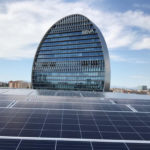BBVA banks on solar energy at its Madrid headquarters
The bank also installed solar panels on two of its buildings in the Autonomous Community of Madrid: the Data Processing Center in Tres Cantos and logistical facilities in Daganzo.

BBVA reaffirms its commitment with renewable energy by deploying a photovoltaic system consisting of 523 units — amounting to 175.21 kWp (peak power) and capacity to generate 236.182 kWh/year — at the Group’s Madrid headquarters. EDF Solar, a leader in industrial self-consumption facilities, was tasked with the delivery of the project, which was completed in November.
The solar panel installation will enable BBVA to reduce CO2 emissions by 106 metric tons, which is the equivalent to planting 8,030 trees. The new facility will boost solar energy production at the headquarters by up to 441 Mwh/year, the equivalent of the annual electric consumption of 126 Spanish households. By taking this additional step — reiterating its commitment to clean energy — BBVA contributes to the fight against climate change and its detrimental impact on the planet.
In addition, BBVA installed solar panels on two bank buildings in Madrid, the Data Processing Center in Tres Cantos and logistical facilities in Daganzo, with the aim of further reducing its carbon footprint. The project was made possible thanks to the Recovery, Transformation and Resilience Plan, financed by the European Union Next Generation.
A total of 942 solar panels were installed at the Data Processing Center in Tres Cantos, with the capacity to generate 460 kW of electricity. This system is capable of producing approximately 330 MWh per year, which is equivalent to 1.4 percent energy savings in the total consumption of the center.
The Daganzo logistical facilities now have 126 solar panels, with a total capacity of 46 kW. This system is capable of generating 69 MWh of power per year, which represents savings of 62 percent in the energy consumption of these buildings. BBVA is therefore demonstrating that sustainability is not only a priority for its large operational centers, but also for its support infrastructure.
Harnessing alternative sources of electricity generation has been a societal challenge since the oil crisis in the 1970s. Today, solar power is a reality and has become the most promising long term potential resource for electricity supply. Clean energy production, reducing dependence on energy imports (fossil fuels), limiting greenhouse-causing emissions, and investing in renewables are key factors for reaching the goals established for the ecological transition.